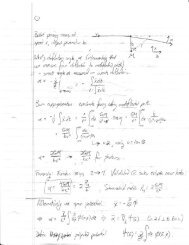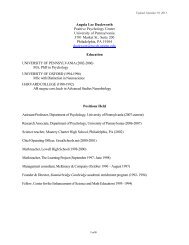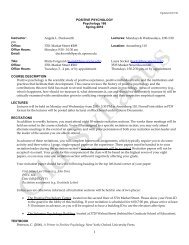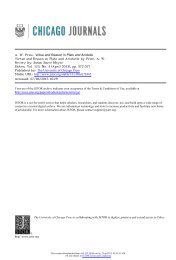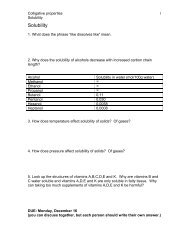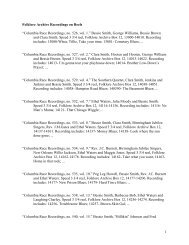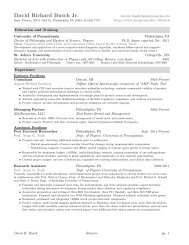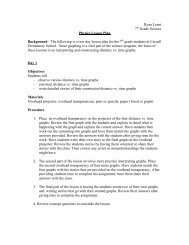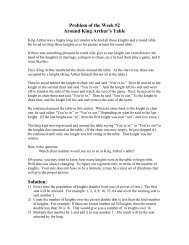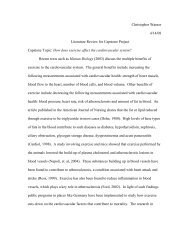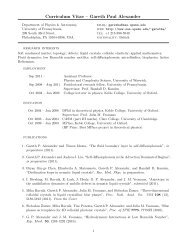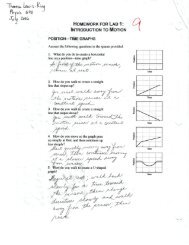Full Lesson Plan - School of Arts & Sciences
Full Lesson Plan - School of Arts & Sciences
Full Lesson Plan - School of Arts & Sciences
Create successful ePaper yourself
Turn your PDF publications into a flip-book with our unique Google optimized e-Paper software.
Bill Wagenborg<br />
Chemistry <strong>Lesson</strong> <strong>Plan</strong><br />
March 2007<br />
<strong>Lesson</strong> Title: Understanding Charles’ Law<br />
Grade Level: 8<br />
Time Frame: 1-2 (45 Minute) Classes<br />
Goals/Objectives: The Students Will Be Able To:<br />
- follow a sequenced plan <strong>of</strong> instructions<br />
- describe changes to gases caused by the addition and<br />
absence <strong>of</strong> heat(rise and fall in temperature)<br />
- use process skills to make inferences and predictions<br />
using collected information<br />
- explain the concepts involved in Charles’ Law through<br />
discussion and written words<br />
Pennsylvania Standards:<br />
3.1.10 E: Describe patterns in nature, physical and man made<br />
systems.<br />
3.2.10 B: Apply process knowledge and organize scientific and<br />
technological phenomena in varied ways.<br />
Opening (Attention Grabber)<br />
Materials: Empty Soda Can, Hot Plate, 1 Liter Beaker, Tongs, Tap Water<br />
Teacher Action:<br />
1.Fill up the beaker with room temperature water.<br />
2.Place just enough water in the soda can to cover the bottom.<br />
3.Turn the hot plate on, place the soda can on top and heat the can until the<br />
water begins to boil. (You should see steam flowing from the top <strong>of</strong> the<br />
can)<br />
4.Using the tongs, grab the can at the bottom and quickly place the top<br />
portion <strong>of</strong> it in the beaker upside down. (The sides <strong>of</strong> the can will crush<br />
inward)<br />
5. Allow students to hypothesize why this occurred and explain that today<br />
they will be doing a lab that may help them understand what happened.<br />
***Caution: Before doing this demonstration inspect the beaker for any cracks<br />
and make sure the students are not extremely close. The force <strong>of</strong> the can crushing in a<br />
beaker with a tiny crack can cause the beaker to break. (This happened to me before<br />
when I was testing it before class. I reinforce the top <strong>of</strong> beaker I use with duct tape before<br />
doing this demonstration in order to prevent any accidents)<br />
1
Materials For <strong>Lesson</strong>:<br />
For Each Group:<br />
2 balloons (be mindful <strong>of</strong> student allergies when choosing the type)<br />
2 250 ml beakers<br />
2 thermometers<br />
2 aluminum pie pans (6-12 inches)<br />
For The Class:<br />
Crushed ice<br />
Tap water<br />
Hot Plate(s)<br />
Pre-Class Questions:<br />
What do you think will happen to a balloon if you heat it? Why?<br />
What if you cool it? Why?<br />
Draw a picture <strong>of</strong> what the gas might look like inside the balloon for each<br />
instance.<br />
<strong>Lesson</strong>:<br />
Part A<br />
The students are broken up into groups and each group will blow up a balloon in a<br />
250 ml beaker. The balloon should fit firmly against the insides <strong>of</strong> the beaker.<br />
They will then place the beaker in an aluminum pie shaped container. This<br />
container will be a water bath filled with room temperature water. Using a<br />
thermometer, the students will take and record the temperature <strong>of</strong> the water and<br />
observe the balloon. They will make a drawing <strong>of</strong> what they think the gas looks<br />
like inside the balloon.<br />
The students will then place the container with the beaker in it, on a hot plate and<br />
heat the water. (We do not have any Bunsen burners or access to gas for that<br />
matter). They will take the temperature <strong>of</strong> the water at equal intervals (every 30<br />
seconds for 5 minutes) and observe what happens to the balloon in the beaker<br />
until the water begins to boil.<br />
The students will be recording all <strong>of</strong> the information and observations in their lab<br />
journals. They also will draw a picture <strong>of</strong> what they think the gas inside the<br />
balloon looks like after the five minutes <strong>of</strong> heating. They will compare this to<br />
their drawing <strong>of</strong> the gas before they added heat to the balloon and the prediction<br />
they made in their pre-class drawing <strong>of</strong> a heated balloon.<br />
Part B<br />
The students will blow up another balloon inside a second 250 ml beaker and<br />
again place it in a room temperature water bath in an aluminum pie plate. They<br />
will record the temperature and observe the balloon’s size in the beaker. They will<br />
make a drawing <strong>of</strong> what they think the gas looks like inside the balloon.<br />
2
Assessments:<br />
The students will then begin to fill the water bath with crushed ice. They will<br />
record the temperature, observe the balloon and add more ice. All will be done<br />
over equal time intervals (30 seconds for 5 minutes).<br />
As they did in part a, they will record all information in their lab journals. They<br />
also will draw a picture <strong>of</strong> what they think the gas inside the balloon looks like<br />
after the five minutes <strong>of</strong> cooling. They will compare this to the drawing they<br />
made <strong>of</strong> the gas before they added the ice and to their pre-class drawing <strong>of</strong> a<br />
cooled balloon.<br />
After the lab (that day if time permits or the following class), we will have<br />
a discussion about what the students observed and what they think may have<br />
caused their results. They will also record their thoughts and experiences with this<br />
lab in their lab journals. I will serve as a moderator/guide and not an answer<br />
person. I want to see what their thoughts are and that they arrived at their<br />
conclusions on their own.<br />
1. The students will be given follow up questions dealing with their lab that<br />
will be used as an assessment. The questions will be phrased in a way where<br />
I will be able to see if they understand why the balloon increased in size in<br />
the hot water and decreased in size for the cold. I want to make sure that<br />
they realize that the volume <strong>of</strong> the gas inside the balloon is increasing and<br />
decreasing.<br />
For example:<br />
• Were your predictions from the pre-class correct? Explain<br />
• Based on your observations, what happens to a balloon<br />
when heated and when cooled?<br />
• What affect does the temperature have that causes the<br />
balloon to act this way?<br />
• Using this lab and what we learned about Boyle’s Law in<br />
our previous unit as a basis, explain why the soda can got<br />
crushed in our opening activity?(If Boyle’s Law is taught<br />
after Charles Law you can just focus on their<br />
explanations from the temperature and volume viewpoint<br />
now, and readdress the pressure at a later point)<br />
2. They will also be given a question on their unit test that takes Charles’ Law<br />
and puts in a “real world” context.<br />
For example:<br />
• Why do the tires on your car appear to be deflated in the morning<br />
after a cold night? How does this show Charles’ Law?<br />
Or<br />
3
• You are a manager <strong>of</strong> a party store. It is a cold day and a person<br />
just buys a bunch <strong>of</strong> balloons before leaving the store. She returns<br />
minutes later complaining that her balloons are deflated. Using<br />
what you have learned about Charles’ Law, give your response to<br />
the customer.<br />
Story <strong>of</strong> Charles Law (See Page 7): During the following class or lab wrap up session,<br />
the students will hear the story <strong>of</strong> how Charles Law came about and how it relates to<br />
balloons. It provides the students with a connection between a science law and a real<br />
world application.<br />
4
Story <strong>of</strong> Charles’ Law<br />
To begin the story <strong>of</strong> Charles law, we should first look at the early<br />
attempts <strong>of</strong> discovery by Robert Boyle and Guilliame Amonton. In 1622<br />
Boyle had published his work on the inverse relationship between a gas’<br />
pressure and volume, a law that would later bear his name. He was aware <strong>of</strong><br />
the increase in volume <strong>of</strong> a gas when heated, but a temperature scale did not<br />
exist then. In the early 1700’s Amonton did many experiments involving a<br />
gas’ volume and its temperature, but like Boyle a temperature scale did not<br />
exist. (Thall, n.d.)<br />
So we can now look at the gentleman who the law is named after.<br />
Jacques Charles was a Frenchman who early on in his life had very little<br />
science education. While working in a Paris Government Office he had a<br />
chance encounter with the American Ambassador to France, Benjamin<br />
Franklin. After hearing <strong>of</strong> Franklin’s experiments and scientific ideas,<br />
Charles decided to teach himself some science. This self teaching eventually<br />
led to public lectures and then to the Academy <strong>of</strong> Science, where he began to<br />
develop a respectable reputation. (Ellyard, 2005)<br />
It was here in 1783 that the Montg<strong>of</strong>ier brothers asked Jacques<br />
to look at their new mode <strong>of</strong> travel, the hot air balloon. After careful<br />
scrutiny, Charles stated that he believed that for the safest and surest form <strong>of</strong><br />
travel the balloon should be filled with” a very light flammable air<br />
(hydrogen) rather than heating the air over fire.”(Ellyard, 2005) In August <strong>of</strong><br />
that year he but his theories to the test. He got his first balloon and filled it<br />
with hydrogen by pouring sulfuric acid over scrap iron (later zinc). He went<br />
to a field, where the Eiffel tower now stands, and sent his balloon up 10 km.<br />
After more trials he soon started to notice that the balloon’s volume would<br />
expand as the balloon went up into lower air pressure. This was not anything<br />
new; it was simply proving Boyle’s Law from 1659. More importantly he<br />
saw a connection between heating the gas and the gas’ volume. (Ellyard,<br />
2005)<br />
In 1787 Charles decided to investigate this relationship further. He<br />
went out and got a J-shaped glass tube that Robert Boyle had used in his<br />
study <strong>of</strong> gases. He placed the tube in a water bath so he could manipulate the<br />
temperature <strong>of</strong> the gas. He held the pressure <strong>of</strong> the trapped gas bubble steady<br />
by “keeping a constant difference between mercury levels in the two arms <strong>of</strong><br />
the tube,” (Ellyard, 2005) This would make pressure a non factor in his<br />
experiments. He then went about changes the temperature <strong>of</strong> the water bath<br />
and observing the effect on the trapped gas bubble. His results showed that<br />
5
the volume <strong>of</strong> the gas rose with an increase in temperature and fell with a<br />
decrease in temperature, (Ellyard, 2005)<br />
This relationship was dubbed Charles’ Law. This may not be fair for<br />
two reasons. First Charles was not the first to discover this relationship.<br />
Gulilliame Amontons had done so in 1702, but Charles’ apparatus was better<br />
and he had more precise measurements. Secondly Charles never published<br />
his work on the relationship between a gas’ volume and its temperature. That<br />
distinction would go to Gay Lussac. (Ellyard, 2005)<br />
After the French Revolution, fourteen year old Joseph Gay-Lussac<br />
went to Paris. It was here that he received private lessons and attended<br />
boarding school. He eventually became an assistant to French chemist<br />
Claude Louis Berthollet who trained him in chemical research. During the<br />
winter <strong>of</strong> 1801-1802, twenty-four year old Gay-Lussac was encouraged by<br />
Berthollet to conduct research on the expansion properties <strong>of</strong> gases. (Green,<br />
Peterson, 1992)<br />
Gay-Lussac wanted to get results that were more accurate than those<br />
obtained by Charles and others. In his experiments he “excluded water<br />
vapors from his apparatus and made sure that the gases themselves were free<br />
<strong>of</strong> moisture.” He concluded that “equal volumes <strong>of</strong> gases expand equally<br />
with the same increase in temperature.”(Lussac, 1802)<br />
There were some differences between his results and Jacques Charles.<br />
First <strong>of</strong> all, Gay-Lussac published his results while Charles did not. Gay-<br />
Lussac also measured the coefficient <strong>of</strong> expansion while Charles did not.<br />
Charles only investigated oxygen, carbon dioxide, nitrogen and air.Gay-<br />
Lussac’s results worked for all gases. Finally, because Charles had water in<br />
his apparatus, his results showed an unequal expansion for the gases that<br />
were water soluble. Gay-Lussac had obtained more accurate results and<br />
published them yet the law is still more commonly referred to as Charles’<br />
Law than Gay-Lussac’s Law. (Green, Peterson, 1992)<br />
Like Charles before him, Gay-Lussac was an avid balloonist. In 1804<br />
he flew to an altitude <strong>of</strong> 23,000 feet which was a record that stood for half <strong>of</strong><br />
a century. Eventually as, Charles predicted, hot air balloons were replaced<br />
by hydrogen filled and later helium filled balloons. In the 1960’s hot air<br />
ballooning became popular again as a sport. (Reese, 2004)<br />
Charles and Gay-Lussac’s results helped other scientists discover the<br />
absolute zero temperature <strong>of</strong> a gas. This is done by locating the theoretical<br />
temperature in which gas has a volume <strong>of</strong> zero. (Ellyard, 2005) This is the<br />
coldest temperature possible. It has never been achieved because gas<br />
liquefies before reaching this temperature and is no longer subject to the gas<br />
laws. (McGrath, 2005)<br />
6
References<br />
Ellyard, David (2005)<br />
Who Discovered What When.<br />
Sydney: Reed New Holland.<br />
Gay-Lussac, Joseph (1802)<br />
Annales de Chimie 43, 137 (1802) [reprinted in William Francis<br />
Magie, ed., A Source Book in Physics (New York: McGraw-Hill,<br />
1935)]. First Section. Retrieved February 19,2007 from<br />
http://web.lemoyne.edu/~giunta/gaygas.html<br />
Green. Jeffery M., Peterson, Andy (1992)<br />
Gay-Lussac-Scientist. Retrieved February 19,2007 from<br />
http://www.woodrow.org/teachers/ci/1992/Gay-Lussac.html<br />
McGrath, Kimberly (ed.) (2005)<br />
World <strong>of</strong> Physics. Farmington, Michigan:<br />
Thomas Gale Publishing. Retrieved February 19, 2007 from<br />
http://www.bookrags.com/research/charles-law-wop/<br />
Reese, K.M. (2004)<br />
Gay-Lussac, Balloon Pioneer. Chemical Engineering News.<br />
Volume 82(25) Pg 56<br />
Thall, Edwin (n.d)<br />
Thall’s History <strong>of</strong> Gas Laws. Retrieved February 19,2007 from<br />
http://mooni.fccj.org/~ethall/gaslaw/gaslaw.htm<br />
*Soda can demonstration and balloon lab based on those found in The<br />
<strong>School</strong> District <strong>of</strong> Philadelphia’s 8 th Grade Science Textbook.<br />
Holt Science and Technology: Introduction to Matter (2005)<br />
Holt, Reinhart and Winston: Austin Texas.<br />
* All photos are the property <strong>of</strong> William J. Wagenborg Jr. and may not<br />
be used by anyone in any way.<br />
7
Pictures To Be Used For <strong>Lesson</strong><br />
Jacques Charles<br />
(http://dbhs.wvusd.k12.ca.us/webdocs/GasLaw/Gas-Charles.html<br />
Joseph Gay-Lussac<br />
(http://dbhs.wvusd.k12.ca.us/webdocs/Gallery/Gallery6.html)<br />
http://discover.edventures.com<br />
8
More Links<br />
These are links to some Charles’ Law graphics.<br />
http://www.1728.com/charles.htm<br />
http://exploration.grc.nasa.gov/education/rocket/glussac.html<br />
http://www.chem.iastate.edu/group/Greenbowe/sections/projectfolder/flashfiles/gaslaw/c<br />
harles_law.html<br />
These are links to more information on hot air ballooning.<br />
http://www.planoballoonfest.org/balloon_history.html<br />
http://www.nationalballoonmuseum.com/exhibits.cfm?exhibitid=18<br />
9



